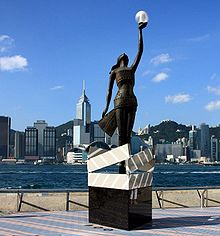
Back سينما هونغ كونغ Arabic হংকংয়ের চলচ্চিত্র Bengali/Bangla سینەمای ھۆنگ کۆنگ CKB Hongkong-Film German Cine de Hong Kong Spanish سینمای هنگ کنگ Persian Cinéma hongkongais French Sinema Hong Kong ID Cinema di Hong Kong Italian 香港映画 Japanese
This article has multiple issues. Please help improve it or discuss these issues on the talk page. (Learn how and when to remove these messages)
|
| Cinema of Hong Kong | |
|---|---|
 | |
| No. of screens | 282 (2024)[1] |
| • Per capita | 3.1 per 100,000 (2011)[2] |
| Produced feature films (2005–2009)[3] | |
| Total | 56 (average) |
| Number of admissions (2010)[5] | |
| Total | 22,500,000 |
| • Per capita | 3.2 (2010)[4] |
| Gross box office (2014)[6] | |
| Total | HK$1.65 billion |
| Demographics and culture of Hong Kong |
|---|
| Demographics |
| Culture |
| Other Hong Kong topics |
The cinema of Hong Kong (Chinese: 香港電影) is one of the three major threads in the history of Chinese-language cinema, alongside the cinema of China and the cinema of Taiwan. As a former Crown colony, Hong Kong had a greater degree of political and economic freedom than mainland China and Taiwan, and developed into a filmmaking hub for the Chinese-speaking world (including its worldwide diaspora).
For decades,[when?] Hong Kong was the third largest motion picture industry in the world following US cinema and Indian cinema, and the second largest exporter.[specify] Despite an industry crisis starting in the mid-1990s and Hong Kong's transfer to Chinese sovereignty in July 1997, Hong Kong film has retained much of its distinctive identity and continues to play a prominent part on the world cinema stage. In the West, Hong Kong's vigorous pop cinema (especially Hong Kong action cinema) has long had a strong cult following, which is now a part of the cultural mainstream, widely available and imitated.
Economically, the film industry together with the value added of cultural and creative industries represents 5 per cent of Hong Kong's economy.[7]
- ^ "香港電影業資料彙編-2018". 創意香港. Archived from the original on 22 May 2021. Retrieved 26 February 2021.
- ^ "Table 8: Cinema Infrastructure – Capacity". UNESCO Institute for Statistics. Archived from the original on 5 November 2013. Retrieved 5 November 2013.
- ^ "Average national film production". UNESCO Institute for Statistics. Archived from the original on 23 October 2013. Retrieved 5 November 2013.
- ^ "Cinema – Admissions per capita". Screen Australia. Archived from the original on 9 November 2013. Retrieved 9 November 2013.
- ^ "Table 11: Exhibition – Admissions & Gross Box Office (GBO)". UNESCO Institute for Statistics. Archived from the original on 3 November 2013. Retrieved 5 November 2013.
- ^ Kevin Ma (6 January 2015). "Transformers, Chickensss rule 2014 HK b.o." Film Business Asia. Archived from the original on 11 January 2015. Retrieved 6 January 2015.
- ^ "Robust film industry is in our best interest". South China Morning Post. Archived from the original on 19 March 2017. Retrieved 1 April 2017.